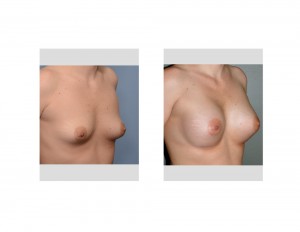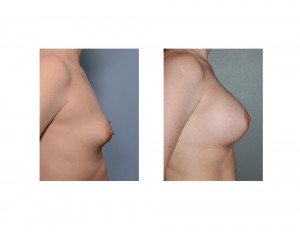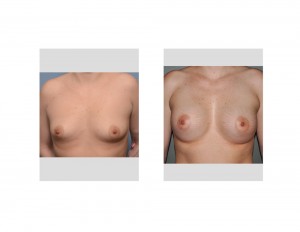Background: Breast implant surgery works by the simple principle of placing a device under the breast tissues that pushes outward and creates a larger breast mound. Regardless of whether the implant is placed under the glandular tissue (subglandular) or partially or completely submuscular the outward result of a larger breast remains the same. Since the implant merely pushes the overlying breast tissue whatever outward breast characteristics that exist (e.g., nipple-areolar size/asymmetry, skin features) will remain the same or may get bigger as the breast mound enlarges.
One of the undesired features of breast skin is that of stretch marks. These skin deformities represent a dermal injury where the skin has thinned in a linear fashion due to expansion of the tissues. Breast stretch marks always appear in a radiating pattern extending outward from the central nipple-areolar complex and running directly perpendicular to the relaxed skin tension lines of the breast mound. (which are circular or concentric) They develop most commonly from pregnancy due to the skin stretch created by breast tissue engorgement. The collagen fibers in the skin’s dermis may also be weakened by the change in hormonal levels. Large amounts of weight gain or naturally very large breasts may also challenge the integrity of the dermis.
Since breast augmentation causes an immediate and large increase of the breast mound, through the placement of an implant and the resultant development of swelling, breast skin may theoretically develop stretch marks. In breasts that already have stretch marks could breast implants make them worse either by appearance or even making them bigger. These would be understandable concerns from any women considering breast augmentation.
Case Study: This 34 year-old female wanted breast augmentation as she had lost some of her breast volume after multiple pregnancies and they had lost any perkiness they once had. She had existing white-colored stretch marks on both breasts that radiated outward from the nipples.


Highlights:
- Pregnancy and extreme weight gain/loss are the most common causes of stretch marks on the breasts.
- Breast augmentation surgery does not cause stretch marks on the breasts if they are not already present.
- Breast augmentation surgery does not usually make the appearance of existing stretch marks worse. (other than temporary redness)
Dr. Barry Eppley
Indianapolis, Indiana



